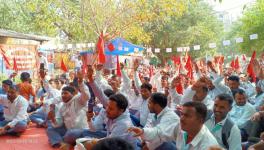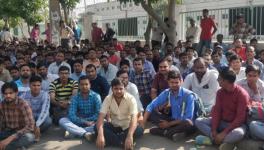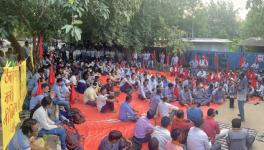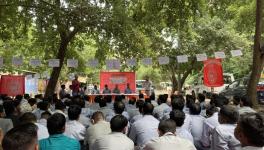Honda Moves Production From Manesar To Other Plants, But What About Striking Workers?
The tool-down strike by nearly 4,500 workers—2,500 contractual and 1,900 permanent—at the Manesar plant of the Honda Motorcycle and Scooter India (HMSI) reached its ninth day on November 13.
Workers have been protesting against the Honda management since November 5, after around 200 contractual workers at the Manesar facility were retrenched last week by the management citing low production and demand fluctuations.
Owing to the labour unrest, the management at Honda’s oldest manufacturing plant in Manear observed no-production for the seventh consecutive day on Wednesday.
Even as the strike continues, it seems to present no-win situation for both the parties—output loss for the company and no wages for the workers. The workers are certainly feeling the heat of the strike, with the management now closing down even the only operational canteen inside the facility.
Also read: Manesar: Honda Workers’ Strike Enters 7th Day, Talks Fail to End Stalemate
However, as far as the country’s second largest two-wheeler maker Honda is concerned, it has increased production at its plants in Rajasthan and Gujarat.
According to an Indian Express report, in order to make up for the output loss at the Manesar unit, workers at the other plants have been doing double shifts.
The industrialists blame the ongoing economic slowdown as the trigger for cutting production costs, bringing down wages, cutting jobs and advancing contractualisation. For the workers, however, the slowdown has meant raging unemployment, unprecedented distress and worsening of their working conditions to boot.
“What kind of economic slowdown is this?” asked Suresh Gaur, President of HMSI Employees’ Union, “Giving low production as a justification to retrench workers is an eyewash as the media reports correctly suggest that productions have been continuing at other plants.”
But there is more to it than meets the eye, says Gaur. Of the 200 contractual workers retrenched now and the 700 workers retrenched earlier in August, many were about to get a permanent status, which would have resulted in an increase in their salaries, among other benefits.
“The workers retrenched now have been working on contractual basis for the past ten to twelve years which is itself a violation of the provisions of the Indian laws,” he said.
Both contractual and permanent workers give equal amount of labour time, yet a contract worker would receive only Rs 14,000 to Rs 16,000 per month while a permanent worker’s monthly salary is around Rs 65,000, Gaur added.
In addition to this, even the wage settlement of both the sections of workers have been pending since 15 months, which has forced the Honda workforce to demonstrate against the management.
“Delay in wage settlement brings huge losses especially to the contractual workers as the increase in wages in their case is not calculated in a retrospective manner,” Gaur told Newsclick.
Also watch: Auto Industry Crisis: Worst in 19 Years
Meanwhile, the Indian economy is in the doldrums, with a prolonged slowdown plaguing every arm of the industrial sector. Speaking of the Indian two-wheeler market, a decline in sales has been registered for the seventh month in a row this year.
As per a Money Control report, HMSI’s volumes have nosedived by 19% to 2.68 million units during the H1 FY20, the biggest plunge by any player in the top five rankings.
But while the effects of the sluggish market conditions are being felt at the production facilities—it has not stopped the Japanese manufacturer from going ahead with its Rs 2,400-crore investment plan, which includes setting up of a new manufacturing line in Gujarat, as reported by the Economic Times.
For workers, who often remain missing from mainstream media narratives, the effects of the crisis in the economy takes its most brutal shape. The Honda episode is only one example of the catastrophe that looms large over the country’s working class.
Get the latest reports & analysis with people's perspective on Protests, movements & deep analytical videos, discussions of the current affairs in your Telegram app. Subscribe to NewsClick's Telegram channel & get Real-Time updates on stories, as they get published on our website.
























